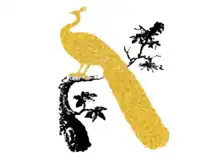
A number of Yiddish symbols have emerged to represent the language and the Yiddishist movement over history.[1] Lacking a central authority, however, they have not had the prominence of those of the Hebrew revival and the Zionist symbols of Israel. Several of the Yiddish symbols are drawn from Yiddish songs in the klezmer tradition.
"Di Goldene Pave" popularized the symbol of the golden peacock,[2] and "Raisins and Almonds" that of a goat, echoing that in Chad Gadya.[3] The golden peacock has been a subject of Yiddish poetry, including a collection under that title from Moyshe-Leyb Halpern. Yiddishpiel uses a logo of golden peacock plumage surrounding its theatre building. The Forward has used gold in its masthead (also recalling Di Goldene Medine) since 2015,[4] and the Yiddish Book Center has used a golden goat since 2012, designed by Alexander Isley with lettering from El Lissitzky's lithographs of Chad Gadya.[5][6][7]
"Oyfn Pripetshik" highlights komets-alef as a distinctive letter in Yiddish orthography, in a play on a Yiddish alphabet song. This particular letter (אָ) is also used to represent Yiddish on Duolingo,[1] replacing a "Yiddish flag" on the pattern of the flag of Israel but in black with a menorah, promoted by a user from Wikimedia Commons which was used for a time in the Duolingo Incubator.[8]
Flags
There is no historical language or ethnic flag for Yiddish speakers, though in the 21st century there have been a couple of minor proposals for digital use as flag icons for languages.
 The komets alef flag, now used for the Duolingo Yiddish course.[1]
The komets alef flag, now used for the Duolingo Yiddish course.[1] Proposed Yiddish flag, that was temporarily used for the Duolingo Yiddish course.[1]
Proposed Yiddish flag, that was temporarily used for the Duolingo Yiddish course.[1] The Yiddish flag in front of a synagogue.
The Yiddish flag in front of a synagogue.
Flag with a menorah
It appeared on the internet around 2012, when it was published on Wikipedia. Rapidly, it disseminated in the internet, becoming number one result in any google search for “Yiddish flag”. Soon after, Duolingo, a vocabulary learning app, started using it for promoting its Yiddish course. Following the publication of the article "What Flag Should Yiddish Fly?",[9] that criticized the flag for its gloomy appearance and resemblance to the flag of Israel (which was considered inappropriate due to an unfavorable policy towards Yiddish in Israel's early years), Duolingo changed it to the komets alef. Despite criticism, the flag remains popular. The claims that the flag originated in anarchist milieu in the early 20th century are not true.[10]
See also
References
- 1 2 3 4 Cherney, Mike (8 April 2021). "Designing a Flag for Yiddish Takes Chutzpah". Wall Street Journal. ISSN 0099-9660. Retrieved 19 April 2021.
- ↑ Fonda, Batya. "The Golden Peacock". Jewish Folk Songs. Retrieved 19 April 2021.
- ↑ Fonda, Batya. "One Only Kid". Jewish Folk Songs. Retrieved 19 April 2021.
- ↑ Stern, Phil (19 April 2015). "A Forward for the Inquisitive Reader". The Forward. Retrieved 19 April 2021.
- ↑ "Why a Goat?". Yiddish Book Center. Retrieved 19 April 2021.
- ↑ "By Design: A New Logo | Yiddish Book Center". www.yiddishbookcenter.org. Retrieved 2022-01-16.
- ↑ "Yiddish Book Center". Alexander Isley Inc. Designers. Retrieved 2022-01-16.
- ↑ Schulman, Sebastian (15 June 2015). "What Flag Should Yiddish Fly?". The Forward. Retrieved 19 April 2021.
- ↑ "What Flag Should Yiddish Fly?". 15 June 2015.
- ↑ "Flag of the Yidish language".
